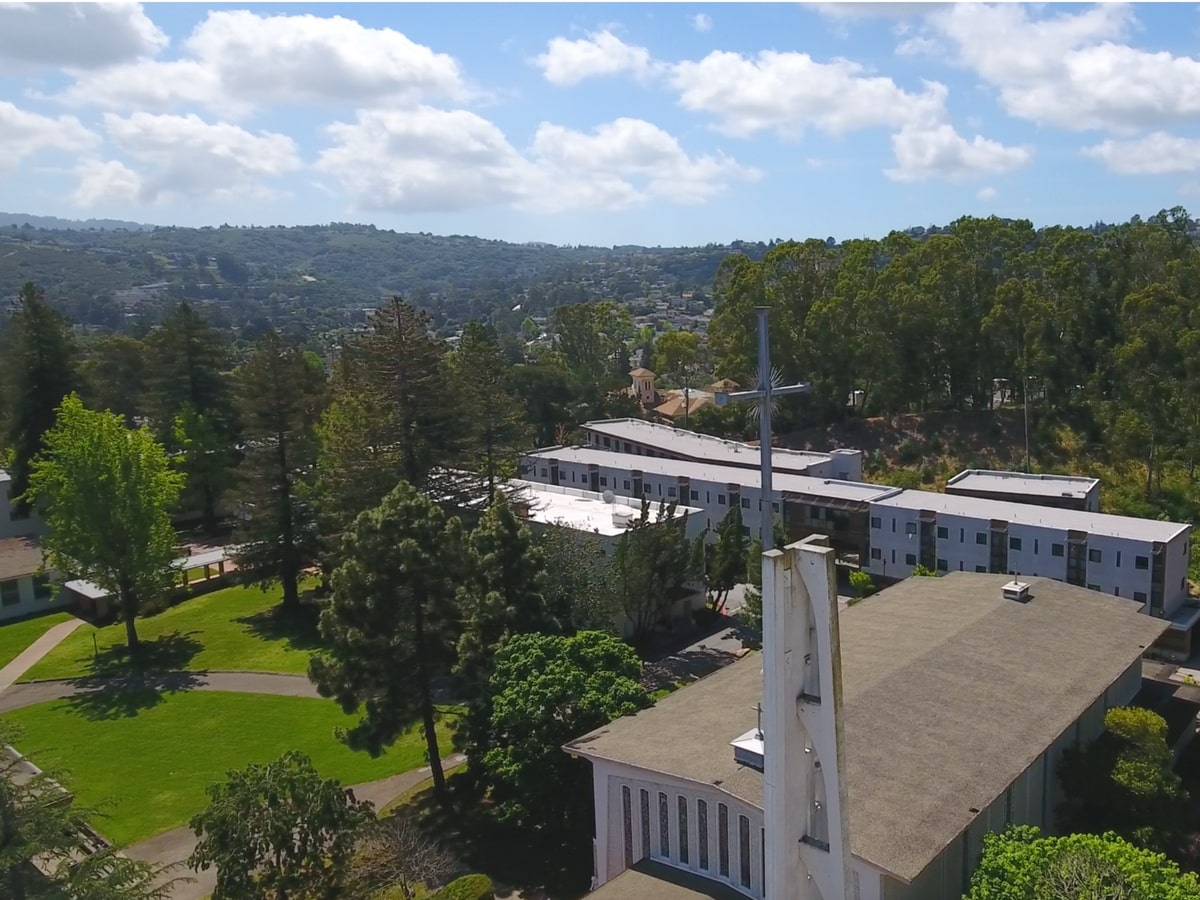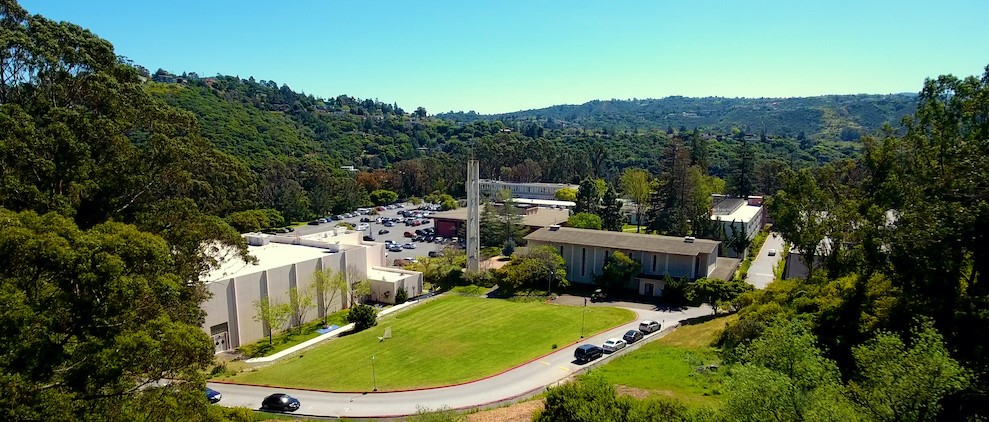Stanford University has reached an agreement to "work toward" purchasing Notre Dame de Namur University's campus in Belmont, both universities announced on Tuesday.
The two schools have signed an agreement that gives Stanford the exclusive right to purchase the property until June 15, 2025, Notre Dame de Namur spokesperson Melissa McAlexander told this news organization in an email. Neither university has specified how much Stanford is planning to pay for the campus, with both saying that "specific financial details remain confidential."
It isn't currently clear exactly how Stanford plans to use the space, with the university saying it intends to undertake a multiyear site-planning process. Notre Dame de Namur will continue its normal operations until the sale is complete, McAlexander said, and will then have the option to lease back space on the campus for its operations.
In the face of a financial crisis, Notre Dame de Namur announced in January that it would "transform into a primarily graduate and online university," with the potential to also offer undergraduate degree completion programs. The decision to sell its Belmont campus to Stanford is part of that change.
"(Notre Dame) has secured its future by finding the potential next owner for this property," Sister Jean Stoner, chair of the Notre Dame De Namur board of trustees, said in a press release. "This will provide resources for many new opportunities to continue the Sisters' legacy of education rooted in the values of social justice and global peace."
Notre Dame de Namur is a Catholic, nonprofit university that was established in 1851 by the Sisters of Notre Dame de Namur. Its Belmont campus is the only location where classes are currently held, spanning roughly 50 acres and including dorms, offices and classroom buildings, McAlexander said.
In a news release, Stanford said it would develop a campus plan with input from Notre Dame de Namur, the Stanford community, the city of Belmont and local residents. Stanford Provost Persis Drell will also work with a faculty advisory group to get direction on potential academic uses for the space.
Stanford expects the planning and campus design process to take several years, starting when the university submits an application to make site improvements that require city approval. The effort is being led by Stanford's Land, Buildings and Real Estate Department.
"This is a unique opportunity for Stanford to support higher education in the region, connect with residents in a part of the Peninsula where we have historically not had as much of a presence and invest in expanding our academic mission in service to the community," Drell said in the release. "While we do not anticipate moving existing teaching and research activities off of the main campus, adding a campus in Belmont will provide us with additional space and facilities to enhance those activities through more regionally-focused work."
Part of the appeal of the property is its existing use as a "residential academic campus" on the Peninsula that is near public transit and Stanford's existing campuses, Stanford's release said. The campus could be used to bring Stanford's continuing studies courses to a broader swath of the Bay Area, according to the university.
"We are delighted to be planning for the future of the Belmont campus in a way that strengthens both universities and our respective connections to the community," Stanford President Marc Tessier-Lavigne said. "We have a chance to envision new and innovative academic uses for the site that are grounded in its rich history and embrace the dynamism of the Bay Area."
Stanford has grown its footprint in recent years, most significantly by opening a 35-acre Redwood City campus in 2019, which houses various departments, including human resources, School of Medicine administration and business affairs.
In recent years, Stanford has wrangled with Santa Clara County over its expansion plans. Citing ongoing disagreements with the county Board of Supervisors, in November 2019 the university abandoned an application for a new general use permit that would have allowed for 3.5 million square feet of new development.
Both Stanford's Redwood City campus and Notre Dame de Namur's Belmont location lie outside of Santa Clara County. They are both within San Mateo County.
Notre Dame de Namur's decision to sell its campus comes as the university reimagines its future in the face of financial challenges. The university announced in March 2020 that it was "experiencing an unsustainable enrollment decline and growing financial crisis," adding that "closing could be in our future," though school leaders sought a way to stay open.
This past January, the school announced its board of trustees unanimously recommended continuing to operate, while switching to a focus on graduate and online education. The university "has narrowed its curricular focus, modified existing programs, and is developing new programs," according to Notre Dame de Namur's release announcing the campus sale agreement.
The San Mateo Daily Journal recently reported that the school is currently in its first semester of the pivot to graduate programs and has roughly 200 students enrolled. The university's offerings include master's degree programs in business, education and psychology, as well as teacher credential programs.
"This agreement between NDNU and Stanford gives NDNU the flexibility to grow again in new and exciting ways," Notre Dame de Namur President Beth Martin said in the release. "We will be able to continue the programs for which we are so well known, and to add new programs directly targeted to changing student needs, including a mix of in-person, hybrid, and fully online programs."




Comments
Registered user
Cuesta Park
on Sep 30, 2021 at 4:46 pm
Registered user
on Sep 30, 2021 at 4:46 pm
The reason Stanford (in Santa Clara County) is under Santa Clara County planning/zonning/development constraints is that SU is on unincorporated land (not City of Palo Alto land). In Redwoood City it is within the RWC borders and within that city's development control sphere.
This new SU campus, seems to be within the Belmont city limits - and will also come under their (city) development control sphers - and NOT San Mateo Co.
course - it seems SU in Santa Clara Co. is within some 'zone of influence' of Palo Alto planning - and hence PA has a smidgen of influence on SU main campus development
Registered user
Monta Loma
on Oct 1, 2021 at 10:09 am
Registered user
on Oct 1, 2021 at 10:09 am
The largest landowner in Silicon Valley is expanding its footprint in San Mateo County. When the Santa Clara County Board of Supervisors tried to force Stanford to mitigate the impact of its development as conditions of approval for the General Use Permit, the university decided to take its ball and go home. Now they are expanding in San Mateo County to continue their expansion plans without mitigation efforts for their growth.